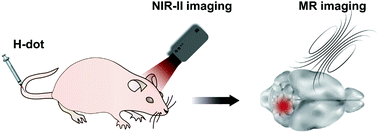Mn-Loaded apolactoferrin dots for in vivo MRI and NIR-II cancer imaging†
Abstract
The integration of molecular imaging probes into a biodegradable, noncytotoxic and biocompatible nanoplatform is very promising for high efficacy tumor diagnosis but is still a great challenge. Herein, lactoferrin (Lf), an iron-binding glycoprotein, was applied to develop a novel molecular platform. Biocompatible Mn-loaded apolactoferrin Mn2+-Apo-Lf-PEG was first prepared. The first dual-modality imaging NIR-II/MRI nanoprobe (H-dot) was then constructed by linking a NIR-II fluorescent probe (CH1055) to the surface of Mn2+-Apo-Lf-PEG via glutaraldehyde cross linking. Cellular studies showed that the obtained H-dot exhibited low toxicity, excellent stability, biocompatibility, significantly enhanced T1-weighted magnetic resonance imaging (MRI) and superior NIR-II imaging optical properties. The H-dot was subsequently evaluated in subcutaneous HepG2 liver xenografts and subcutaneous/orthotopic U87MG glioblastoma xenografts, revealing its excellent dual imaging properties in small-animal models for the first time, such as high tumor specificity and contrast, good tumor uptake, and accurate tumor delineation. These particular properties of the Mn-loaded apolactoferrin dot make it a promising molecular platform for the development of novel imaging probes and clinical translation.



 Please wait while we load your content...
Please wait while we load your content...